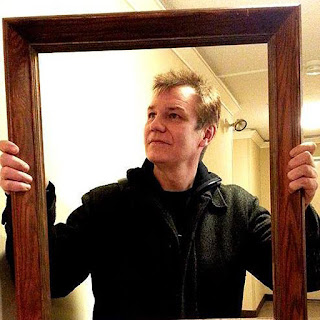Patrick Grant – “FIELDS AMAZE and other sTRANGE music” interview
Patrick Grant – “FIELDS AMAZE and other sTRANGE music” (Peppergreen Media) interview
Patrick Grant put out A 20th Anniversary Edition of FIELDS AMAZE and other sTRANGE music at the beginning of this month. The LP comes from his early days as a composer and is remixed, remastered, and even includes bonus tracks. Grant was kind enough to answer some questions on the release and shed some light on his process as an artist.
You’ve mentioned before that Chaos Theory’s ‘strange attractors’ have informed a lot of your past work, which shows up in this re-release. Could you share with us a bit about what ‘strange attractors’ are and how they’ve influenced your work?
Self-generating structures have always fascinated me. They seem to imply ‘life,’ even if a consciousness is not automatically evident. One area of interest is that of dynamical systems: defining the dependence of time on points moving in space. A study of how fluids interact is one example. Clock pendulums and how the weather behaves are two others. An attractor is a point in these systems where things tend to evolve. When these attractors are fractal in nature, they are considered ‘strange.’
The science of Chaos Theory came to public attention in the 90s and I was all over it as were many other artists because of its implications in creating new ways of working. There were great websites like The Fractal Music Lab that had free software one could download, input your variables, and reams of content would come out. I mean, not that it sounded so great just-like-that, but as raw material for a composer to use, it offered new ways of looking at and using structure that was self-similar and self-described.
I found that these simple musical processes sounded exactly like that: simple. However, if I could layer or intertwine at least three different processes within a section of music, it not only took on a unique shape, but it had strange kind of organic quality, more so than if I were to rely on my taste alone. This is where my use of “strange music” was born.
All of these processes continue to be a part of my music to this day, great or small, depending on the need of each piece. It’s a means to relate one’s work to nature.
Your music has been described before as post-minimalism. Do you feel this is accurate?
I can see that would be easy for someone to say about this album, considering its place in time and its point of origin—NYC in the 90s. One could also say that the music is pre-minimalist considering the use of gamelan, the references to Satie, and a willingness to look toward indeterminacy when faced with tough decisions. If I had to chose, I’d say my work is often minimalist with a lowercase “m.” That is, I like boiling things down to their common denominator when possible, when it’s elegant. I ask, “How can we express ourselves sufficiently in as few moves as possible?”
Recently I’ve been responding to such questions of style by saying my music is “post-progressive” because 1. it satisfies the query, and 2. it means nothing at all.
You’ve made clear that you seek to destabilize “musical styles” in your work, sometimes to arrive at a kind of “synthesis.” With this in mind, how do you feel about people assigning labels to your work?
I wouldn’t say “destabilize,” but that does go back to the need to find a common denominator. Instead of “having a foot in both worlds,” I’d rather express it as “I balance and embrace opposing musical truths.” I have said that the most credible way for me is to do so is to begin at a DNA level when seeking musical commonality between things, styles, or even between personalities. I have never met an artist who is happy when people assign labels to their work, so, if I can confound and delay someone from doing so, in what is always a bad choice of words, at least I can have that.
I’m hearing quite a bit of Steve Reich and, of course, Philip Glass in “Fields Amaze.” Did you have specific influences in mind when composing this track and others on the release?
Reich has always resonated with me more than Glass, though they each have their undeniable thing. It was great to record at Looking Glass Studio because it gave us a first hand look at how certain kinds of work got done. In this case, it was all about the recording process and it was my first real application of ProTools. It was, in essence, recording classical music using pop recording techniques. There’s such an emphasis on getting a great sound, a studio sound, and that’s very different from that of live performance.
As for the title track “Fields Amaze,” one of the performers told me that it reminded her of The Who, and I think she’s right. I also hear other things too: Bach clavier concerti, West Side Story, Kraftwerk, The Isley Brothers, Beethoven, even some James Brown. The list goes on.
The transition between “A Visible Track of Turbulence II” and “Imaginary Horror Film – Part 1” highlights a stark contrast in instrumentation and aesthetics. What kind of thought do you give to ordering tracks within an album? Is juxtaposition an important part of your creative process?
Glad you picked that up! If this was a vinyl album, and it’s not, that would have been the break between Side A and Side B. That was a happy accident, but in general, I always take the sequencing of tracks very seriously. It’s even mentioned on the inner jacket to the CD. I know many people do not listen to albums this way any more, from beginning to end, but for those who do, great care was taken.
Also, a number of the tracks have this “eye of the hurricane” center. You can hear it on “The Weights of Numbers,” but I used centers in “Turbulence” and “Horror Film” as split points. I figured that, not only would this help in keeping the ears of the listener fresh during these longer than normal tracks, but I liked the way this made them seem episodic, like a TV mini-series or movie sequels.
The textures in “The Weight of Numbers” evoke, for me, a fast paced Herbie Hancock. What role does tempo play in your creative process?
The textures and timbres in “The Weights of Numbers” contain a lot of detail. The six hands of the three keyboards are split and divided across the stereo field. They interlock. Each hand goes through about 33 different keyboard sounds. That means there is over 180 sounds on this one tracks. That was so tricky to balance because many of the rhythms make sense only if you can hear every layer that’s interacting with it. The odd-numbered patterns come from science-based models and the even-numbered rhythms are transcriptions of patterns from West Africa.
There are no real tempo changes that the musicians adhere to on “Weights,” but it can seem that way because the structure is metrically contacting or expanding every single moment.
Some tempo changes worth pointing out are the ones in “A Visible Track of Turbulence.” At the end of each section, eighth notes go into triplet patterns. These triplets then become the eighth notes of the next section, and then again, until it becomes frighteningly fast. It’s a basic metric modulation, but very effective and easily felt.
Also worth mentioning are the tempo swings in “Everything Distinct…” Through its three big sections, the tempo is always swinging from 90 BPM to 120 BPM every 27 bars. However, it feels really different every time depending on the core rhythms of any arch. Minimalism! Getting the most out of every tiny element.
I recently read a review that compared you to Frank Zappa. Given your inclination to marry eclecticism and disorientation with classical composition, I’d agree. How do you feel about this comparison? Do you ever set an intention to disorient your listener?
Yes, I’ve read that, it’s a compliment of sorts, but I can’t say that I agree. Then again, I haven’t heard as much Zappa as some people, so maybe. My gut feeling is that this statement says more about how much music incorporating classical, world, and rock these people must have heard. If Zappa is their only frame of reference in this matter, then that’s what they’ll hear.
I will say that Zappa and I both share a reverence for Nicolas Slonimsky, writer, composer, and champion of new music. One of his many, many achievements was the creation of his “Thesaurus of Scales and Melodic Patterns.” I was greatly influenced by the material I found in its appendix. There I found the Mother Chord, The Grandmother Chord, and Four Mutually Exclusive Triads. I also made use of eight and nine note scales. All of these can be heard in “Imaginary Horror Film.” Musically astute people will find many an instance in that piece where I use Twelve Tone Technique in the service of deconstructing (pause) Twelve Tone Technique. I do everything possible to make it sound tonal.
Back to your question, I do not like “eclecticism” as a word to describe music. Not at all. Few do. It certainly doesn’t describe mine. It strikes me as lazy, or worse than that, it gets used to describe music that doesn’t have a definable style of its own, no matter how well crafted it might be. Do you know what I mean? I’ve been to concerts where I’ve heard pieces that were wonderfully performed and obviously well put together, but the next day I can remember nothing about the music. Nothings sticks. For me this is usually because the composer doesn’t have a definite point of view (stylistically canceling oneself out) or that it was coming from a place too foreign to the composer’s actual experience (jokey arrangements et al.). Some people like the word. What can I say?
Now, I would never intend to disorient a listener unless I had the means to set them straight again afterward. That’s the prestige. Inside the physical CD of FIELDS AMAZE and other sTRANGE music there is a flowchart of contemporaneous influences. Many of these influences remain. I consider this flowchart just as much a part of the listening experience as the album itself.
It’s broken up into roughly four equal sections: classical, world, rock, and items pertaining to recording and music technology. I had a very difficult time trying to make an accurate flowchart, where Item A flows into Item B, etc. I just gave up and decided that I better use a chance operation to put these items into the boxes. So, while the four sections do contain the items appropriate to their category, what they flow in and out of is rather surreal and surprising. I’m OK with it. I see it as “a 2-dimensional representation of a 3-dimensional experience.” In this way, its imperfection is perfect and is actually closer to the truth than if I forced too tight a narrative upon it.
You’ll see that one of the items in the flowchart is “misdirection.” This is perhaps the closest I’ll come to answering your question on disorientation. Here, the word “misdirection” is meant as used by stage magicians and sleight of hand artists. You see, if possible, I’m happy to use your own listening preconceptions to make you hear something else, something that you did not know was there all along. When this works, I hope it makes the listener wonder how many other things are going on that they’re not noticing, not just in the music, but in all things that are way bigger than that. It is an aim.
– Gabe Kahan
© Copyright http://www.psychedelicbabymag.com/2018
Array





